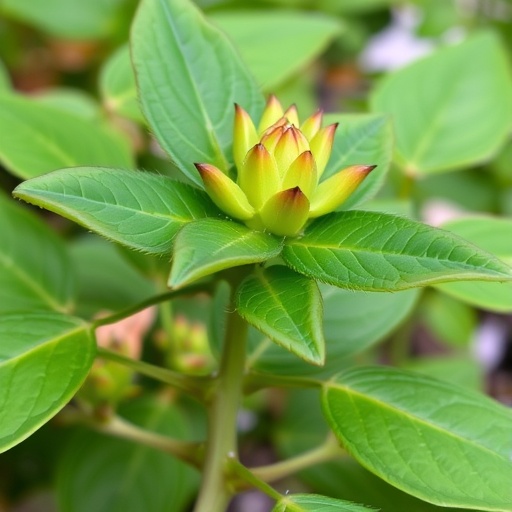The realm of botanical research has made significant strides in understanding the complex interactions between plant-derived compounds and human health. One particularly intriguing study published in Scientific Reports sheds light on the potential therapeutic benefits of Sida rhombifolia Linn., a plant noted for its traditional medicinal use. This research by Aniyan et al. offers compelling evidence for the phytochemical properties of S. rhombifolia, focusing particularly on its anti-inflammatory and antioxidant effects.
Sida rhombifolia Linn. is a perennial herb known for its wide distribution in tropical and subtropical regions. Traditionally, various parts of the plant have been utilized in folk medicine to treat ailments ranging from inflammation to infections. Aniyan and colleagues embarked on an empirical analysis to investigate the specific phytochemicals present in this species and assess their biological activities. Their findings contribute to a growing body of literature that underscores the importance of exploring plant-based solutions in modern healthcare.
Phytochemicals are bioactive compounds found in plants that have been shown to promote health through diverse mechanisms. The research team utilized advanced extraction techniques to isolate these compounds from Sida rhombifolia leaves, focusing on flavonoids, alkaloids, and phenolic acids, which are known for their antioxidant properties. Subsequent qualitative and quantitative analyses revealed a robust profile of these phytochemicals, providing a foundation for understanding the plant’s therapeutic potential.
A segment of the study focused on the antioxidant capacity of the phytochemicals. Oxidative stress is a significant contributor to chronic diseases, including cancer and cardiovascular disorders. By employing a series of in vitro assays, Aniyan and colleagues demonstrated that the extracts of S. rhombifolia exhibited potent antioxidant activity. This is crucial, as it suggests that these extracts may neutralize free radicals more effectively than many conventional antioxidants currently on the market.
In addition to examining antioxidant properties, Aniyan’s team also evaluated the anti-inflammatory effects of S. rhombifolia extracts. Inflammation can manifest in various forms and is often the underlying cause of numerous health issues. The researchers conducted several assays to measure the extracts’ ability to inhibit pro-inflammatory cytokines, which are signaling molecules that contribute to inflammation. The results were promising, indicating substantial anti-inflammatory activity, which supports the traditional use of the plant in managing inflammatory conditions.
The methodologies employed in this study were meticulous, ensuring that the findings are both robust and repeatable. The use of controls and replicates in testing provides credibility to the results. Furthermore, the study’s reliance on standardization in the extraction and analysis processes allows other researchers to replicate the study, which is crucial for scientific validation. In the fast-evolving field of medicinal plant research, reproducibility is key.
Looking ahead, the implications of this research are vast. Aniyan et al. envision that with further investigation and clinical trials, extracts of Sida rhombifolia could eventually lead to the development of new therapeutic agents. The escalating global interest in herbal medicine and natural products promotes alternative and adjunctive therapies to synthetic pharmaceuticals, making such studies increasingly relevant.
Moreover, understanding the molecular mechanisms through which these phytochemicals exert their effects is a priority for future research. By delving deeper into the biochemical interactions, the team hopes to profile specific compounds responsible for the observed biological activities further. This could lead to a clearer path for deriving new medications aimed at fighting inflammation and oxidative stress-related diseases.
It is also essential to consider the potential for integrating this knowledge into holistic health practices. As public interest in natural health solutions grows, the challenge lies in balancing traditional uses with scientific validation. Education and awareness will play a vital role in this integration, ensuring that consumers are informed about the efficacy and safety of herbal treatments.
The study also opens the door to interdisciplinary collaboration among botanists, pharmacologists, and healthcare practitioners. By working together, these professionals can explore the synergistic effects of combining various herbal extracts or even integrating them with traditional therapies to enhance patient outcomes. Such collaborations could lead to groundbreaking advancements in how we approach treatment for chronic inflammatory conditions.
As we advance into an era where personalized medicine is increasingly becoming a reality, understanding individual responses to plant-derived compounds will be paramount. Factors such as genetics, lifestyle, and existing health conditions will play substantial roles in how effective these herbal remedies can be for different individuals. Continued research is necessary to explore these variations and develop tailored treatments based on individual profiles.
In summary, the research conducted by Aniyan et al. shines a spotlight on the valuable contributions of Sida rhombifolia to the field of phytomedicine. It reinforces the idea that the natural world harbors a wealth of untapped resources that, when studied, could lead to significant advancements in healthcare. This particular study serves as a stepping stone toward understanding the clinical relevance of plant-based therapies and paves the way for further investigations into the medicinal properties of various other plants.
As we conclude our exploration of this fascinating research, it’s evident that the synergy between traditional knowledge and modern science can yield promising results. The story of Sida rhombifolia is not just about a plant; it’s an embodiment of nature’s potential to nurture human health, bringing together history, science, and innovation. By continuing to explore and validate these natural remedies, we can contribute to a holistic understanding of health that respects both ancestral wisdom and contemporary scientific inquiry.
Subject of Research: Phytochemical analysis and biological activity of Sida rhombifolia
Article Title: Sida Rhombifolia linn: an empirical analysis on phytochemicals and an in vitro outcome on anti-inflammatory and antioxidant perspective.
Article References:
Aniyan, K.Y., Ganesan, A., Krithika, C.L. et al. Sida Rhombifolia linn: an empirical analysis on phytochemicals and an in vitro outcome on anti-inflammatory and antioxidant perspective.
Sci Rep (2025). https://doi.org/10.1038/s41598-025-26447-6
Image Credits: AI Generated
DOI: 10.1038/s41598-025-26447-6
Keywords: Sida rhombifolia, phytochemicals, antioxidants, anti-inflammatory, medicinal plants
Tags: anti-inflammatory properties of Sidaantioxidant effects of Sida rhombifoliabioactive compounds in plantsempirical analysis of phytochemicalsextraction techniques for phytochemicalsflavonoids and alkaloids in Sidamedicinal plants researchphytochemicals in Sida rhombifoliaplant-based solutions in healthcareSida rhombifolia health benefitstraditional medicinal uses of Sidatropical herbal remedies





